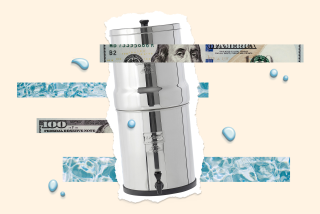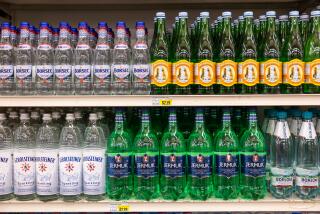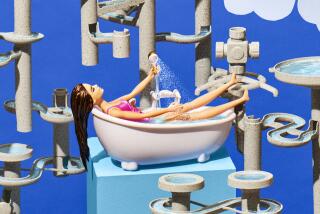Liquid Asset
- Share via
When Bill and Chris Wallace moved from San Francisco to a Wilmington condo four years ago, they got a quick lesson in Southern California water.
“I started finding pinholes in my clothes as I took them out of the dryer. The hard water caused the soap to stick and eat through the fiber,” Chris says. “My hair also felt heavy and dirty, even after I washed it.” Worse, she’d come out of the shower itching.
Since water softening systems are too bulky and expensive for apartment use, the Wallaces were forced to improvise. Their solution? Bill lugged home 100-plus-pound filtration tanks, and connected them to the shower, going through a new tank every two showers. Did we mention they lived on the second floor, with no elevator?
Their supplier was Rayne Water conditioning systems, a national corporation for which, interestingly, the Wallaces are the Santa Monica franchisees. “We figured if anyone could come up with a solution, we could,” Bill says with a laugh. After a year and a half of this, and of taking showers at the Y where the water was softer, the Wallaces came up with the only long-term solution they could think of: They moved.
This is one example of the lengths people will go for suitable water. Not that everyone agrees that water quality needs improvement.
Says Pankaj Parekh, manager for regulatory compliance at the Los Angeles Department of Water and Power: “Water quality has gotten better over the last 20 years. There are a whole bunch of people who don’t use these filters and are just as healthy and safe as those who do. But society’s taste has changed.
“Water filtration systems are not about safety but aesthetics. So, the consumer has to ask, what are we really getting for our investment?”
Bob Gomperz, spokesman for the Metropolitan Water District, says that while water make-up differs in different areas, it all meets minimum state and federal quality standards.
Despite such reassurances, the water treatment industry is growing by 11% annually nationwide. Overseeing it all is the Water Quality Assn., an Illinois-based trade group that annually certifies about 250 water treatment systems. It also gives free consumer advice on available systems. (The group can be reached at [630] 505-0160).
Water quality and composition vary markedly from place to place. Thus, San Fernando Valley water, which comes largely from the Owens Valley, is substantially softer than Santa Monica water, which comes largely from local wells. Beverly Hills water, which averages five grains of dissolved calcium and magnesium per gallon, is five times softer than Santa Monica’s 26, and eight times softer than Ventura’s, where hardness leaps to 40 grains per gallon, Bill Wallace says.
Federal guidelines warn of potential hard water problems when grains exceed 3.5 per gallon. At 7 grains per gallon, water is considered “hard”; at 10.5 grains it is considered “very hard.”
Nor is hardness the only variable. With all sorts of dissolved pollutants, no one type of system is appropriate for all kinds of water. There are, however, four major types to choose from, says Dan Hildevrandt, the Water Quality Assn.’s lab chemist.
* Carbon filters are composed mostly of granulated charcoal, most often pressed into a brick. These filters absorb heavy metals, chloroform and chlorine, as well as foul taste, odors and color. Carbon filters, however, do not soften water. In addition, they must be periodically replaced, and can be used only with cool water.
* Resin-based water softening systems most often plug into the incoming house water pipe. The active ingredient is a resin loaded with sodium ions, the base element of salt. Calcium, magnesium and other dissolved metals stick to the resin, “kicking out” the sodium. The resulting water feels a bit salty. Water softening systems, however, are bulky and must be periodically recharged.
* Reverse osmosis sends pressurized water through a semipermeable membrane that acts like that on a human cell, filtering out more than 90% of all impurities. But these systems are even bulkier than water softening systems, and are “so ridiculously expensive,” they are used only as a last resort, Hildevrandt says.
Most reverse osmosis systems store filtered water in a two-gallon tank and supply drinking and cooking water from that.
* Distillation units boil water into steam, recondensing the purified water into a holding tank. Distilled water is considered the purest, with a better than 95% reduction in contaminants. It is recommended for people with high blood pressure or on severely salt restricted diets. Because of its size and expense, however, it is used mostly by industry.
So, which type of system should you buy? It depends on what’s in your water. Call your water department for test results, which are usually free. In general, Hildevrandt says, certified products sold by competing companies are “fairly similar.”
The best protection is to look for association certification and to have the contractor specify in writing exactly what the system is supposed to do. Generally, the better companies have representatives who will help you work through the alternatives. The catch is to find a company willing to work with you if you have an unusual problem and are not buying a major system.
Of about two dozen companies contacted by one consumer to help solve a difficult--although not particularly profitable--problem, only three went out of their way to suggest solutions: Rayne Water Systems, Santa Monica at (800) 594-3300, Multi-Pure Water Systems in Chatsworth at (800) 622-9206 and Waterworks in Hermosa Beach at (310) 379-2837.
More to Read
Inside the business of entertainment
The Wide Shot brings you news, analysis and insights on everything from streaming wars to production — and what it all means for the future.
You may occasionally receive promotional content from the Los Angeles Times.










